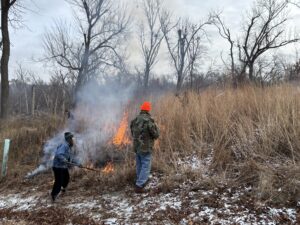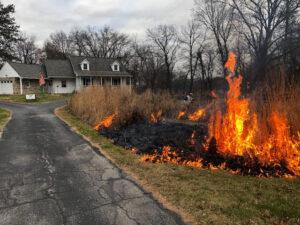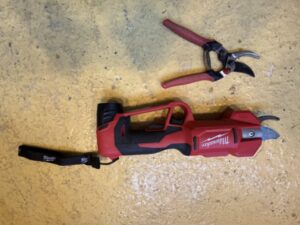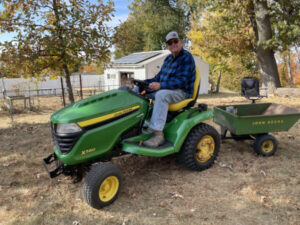by Winding Pathways | Dec 12, 2024 | 1080 Labyrinth Blog, Flowers/Grasses, Garden/Yard, Labyrinths
Humidity makes a huge difference when it comes to fire. So does the wind.
On mid-morning December 3, 2024, two Cedar Rapids Gazette reporters and a photographer arrived at Winding Pathways to experience a prairie burn. We’d set the date ahead of time, hoping burn conditions would be ideal. They weren’t, but we decided to give it a try.
The humidity was around 75% with barely a puff of breeze.
We aimed to burn our backyard prairie to reduce brush and encourage next year’s wildflowers. With low humidity cured prairie grass burns almost explosively, sending flames towering above the ground.
On the high-humidity morning, we struck a match and started an unenthusiastic fire that crept along the ground and only burned hot a few times. Then it died all by itself. We called it a day.
-

-
Olivia and Rich
-

-
Learning to pull fire.
-

-
Photographer filming
Three days later we tried again under very different conditions. The humidity was down to about 40% and a pleasant and steady southwest wind blew at around 10 miles an hour. What a difference! The fire roared across our prairie, consuming grass it had ignored three days earlier. Marion lit the prairie around her labyrinth and it also roared.
-

-
Low humidity burn
-

-
Fall burns allow forbs to grow.
Dry grass is especially sensitive to changes in humidity. When humidity rises grass quickly absorbs the dampness. When humidity drops, grass sheds moisture just as quickly and is ripe to burn. Wood does the same thing but much slower.
Our burning is now over for the year. We know it will stimulate an amazing array of colors next midsummer when wildflowers are in full bloom.
-

-
Colorful Flowers
-

-
Colorful flowers line the path.
-

-
Prairie grasses capture moisture.
by Winding Pathways | Dec 5, 2024 | (Sub)Urban Homesteading, Energy Efficiency, Garden/Yard, Garden/Yard
*Note: Below are just a few examples of several power tools we’ve purchased. They were pricey but made yard work so much easier than with muscle-powered tools. Occasionally, a company asks us to try a product and give reviews.
Yard work was a snap when we were in our 20s. That was a half-century ago! How can that possibly be? Years slipped by. We’re just as eager to mow grass, rake leaves, plant gardens, prune shrubs, and shovel snow, but muscles and joints make the work challenging. Fortunately, we’ve found ways to make yard work and house repairs easier for us as aging homeowners. People with reduced strength or mobility and even younger people with busy schedules will find these tips handy.
Here are some ways we’ve made yard management easier:
Invest in Tools
Tool companies have made yard care easier and safer than in the old days. We used to use muscle-powered tools to trim hedges and shrubs, cut and split wood, rake leaves, move snow, and till the garden. As we got older we began investing in power tools that make the work easier and faster.
For example, an old fashioned “weed wacker”, powered by arm muscles, cut down tall grass growing into pathways and our woods. That got harder each year, so we invested in a Milwaukee brand battery-powered tool that fuels a weed cutter, pole saw, and hedge trimmer. The work is quick and easy. Same with our lopping shears for trimming trees. A battery-powered pruner does the tough cutting easier than hand muscles.
-

-
spring loaded vs battery
-

-
Long handle
-

-
Muscle powered shears next to hedge trimmer.
We always had a gas lawn mower but often struggled to pull the darn starter cord. When EGO came up with a battery-powered mower we eagerly bought one and got rid of the old gas mower. The EGO starts by pushing a button, and it’s self-propelled. We have to walk behind and guide it, but it chugs along under its own power. That’s especially helpful when we mow trails on our hillside.

The EGO snowblower starts with a push of a button.
Snow shovels! Well, we still have a few and use them in tight spaces, but our relatively new battery-powered snow blower makes clearing our 440-foot driveway a snap and eliminates the need to lift heavy snow and pull a starter cord.
Those are just a few examples of several power tools we’ve purchased. They were pricey but made yard work so much easier than with muscle-powered tools.
Hiring and Borrowing
This past season we did a “first”. We hired a young woman to help with gardening. And, we sometimes hire a local teenager to mow our lawn. Years ago we wouldn’t have dreamed of hiring anyone to do what we could do. That’s changing. Having extra hands to help is money well spent.

The tractor made hauling wood easier.
It’s not always hiring help. We swap. By late October Rich had cut and split a small mountain of cordwood we’ll use to stay warm this winter. There was a problem. It was on the north side of our property and down a steep hill. In past years he’s hand carried it uphill. Not a small task to muscle 2000 pounds of wood in 50 round trips carrying 40 pounds up the hill each time. Whew. This year a neighbor came to our rescue. Rich borrowed his tractor and trailer and moved all the wood up the hill in a jiffy. From time to time, we have loaned him some of our tools in exchange. Borrowing works both ways.
We pride ourselves on our independence and take joy in yard work, but we just turned 75 and aren’t quite as frisky as we once were. Using power tools, hiring help, and cooperating with neighbors all make keeping up with the yard easier.
by Winding Pathways | Nov 28, 2024 | (Sub)Urban Homesteading, Foraging

Creating dinner
This fall we borrowed a Nut Wizard nut picker-upper from a friend and helped neighbors harvest gallons of black walnuts. We dumped them in our backyard and, over several weeks, delightedly watched a progression of squirrels haul them off to eat and bury.
They scurried off in all directions carrying a single nut in their teeth. After hundreds of squirrel trips our nut pile was gone. Those ambitious squirrels buried walnuts all over our property.
Derecho Destruction and Re-seeding Nut-Bearing Trees
Most folks don’t want or need walnuts sprouting in their yards but want to clear the yard of various nuts that fall from trees each autumn. The simple answer is investing in a nut wizard or borrowing one. This handy gizmo, which comes in several brand names, rolls along easily capturing nuts that you can then drop into buckets to dispose of. Eastern Iowa suffered a huge tree loss in 2020 when a derecho smacked us with 140 mph winds. Mature trees fell like matchsticks. Since then, we have been “reforesting” timber patches and urban streets and yards. Using a nut wizard to pick up nuts and re-purpose them helps reforest our area. This is a far better option than dumpstering them. A local nature center or park might be a good option to help replant lost trees. Or you can learn to shuck and process nuts for eating.
Squirrels Do the Work

Squirrels bury nuts in caches to retrieve them later.
Back to our squirrels. One morning we watched one use its front legs to dig a hole beneath our window, drop a nut in, cover it with dirt, and pat it neatly down. We’re sure it will be its breakfast on a cold January morning. Not all nuts get dug up, so we expect to find walnut seedlings all over our yard in the coming years.
Nuts An Amazing Food
Nuts are an amazing food for squirrels and people. Unlike most foods, nuts don’t spoil for months. Humans worldwide throughout history harvested walnuts, hickory nuts, filberts, chestnuts, and acorns and put them into storage for delicious eating during food-scarce winters.
Nuts are loaded with protein, oil, fiber, and vitamins. Squirrels, many bird species, deer, bears, and chipmunks have always eagerly gathered and stored wild nuts, but generally people today shun harvesting for good reason.
In past years people gathered and processed nuts. It took time and effort to collect, process, and store them. It’s much work. Planned “nutting parties” were somewhat festive occasions where neighbors gathered to collect and process nuts together. Probably many tall tales and gossip were shared that made the tedious processing more interesting.
Today it’s much easier to buy nuts at the grocery store but wild nuts remain a viable food.
Common Nuts for Wildlife and Human Food
Black Walnuts: Common in suburbia and woods edges, black walnut trees drop messy nuts by the zillions every early fall. Removing the husk, cracking the shell, and picking out the nut meat is a tedious and messy chore that yields delicious additions to cookies and cakes.
Chestnuts: The American Chestnut tree once ranged throughout Eastern North America and produced enormous quantities of nuts that were relatively easy to collect and process. Unfortunately, an exotic blight killed nearly all the trees a century ago. Today similar nuts are dropped from related Chinese and hybrid trees that resist the blight.
Hickories: Pecans are a species of hickory that grow mostly in the south, but Shagbark and Shellbark Hickory have a much wider range and are equally delicious. One hickory, the Bitternut, produces nuts so bitter even the squirrels leave them alone.
Acorns: Oaks worldwide produce nutritious acorns esteemed by wildlife but generally shunned by people. We prefer gathering White Oak acorns and processing them carefully before storing the resulting flour to add to muffins, pancakes, and cookies.
We’ve shared information on how to identify, collect, process, and eat nuts in past blogs. Plenty of information is also online on how to do it.
-

-
Messy
-

-
Nut Wizard
-

-
Rolling up walnuts is easy.
At Winding Pathways we’re so happy to share walnuts with squirrels that we use a Nut Wizard to collect them in friend’s yards and bring them to ours.
by Winding Pathways | Nov 21, 2024 | (Sub)Urban Homesteading, Mammals, Nature
Flying squirrels are phantoms of the darkness. Are they nearly invisible waifs, ghosts, or fascinating and beautiful mammals? Fortunately, they are real, moderately common in good habitats, but hardly ever seen by people.
Marion recalls her Uncle Bill taking her outside one evening in Florida. Quietly they waited at dusk and suddenly, a petit squirrel launched from a tree and glided past. A thrilling sighting for a seven-year-old and a fond memory all these years later.
For many years a colony of southern flying squirrels lived in a massive hollow elm at the Indian Creek Nature Center. Although their tree was next to a busy trail, daytime hikers never saw the animals. Many times, I’d lead people to the tree as darkness gathered. We’d sit quietly. Just as it became almost, but not quite, so dark that vision was impossible squirrels would appear from a hole in the tree. We couldn’t really see them glide but could hear a rustle of leaves as one landed nearby. Flying squirrels are delightful.
Two Species
Many people live close to them and don’t realize it because they are so nocturnal. Two species live in North America. The northern flying squirrel lives mostly in Canada, and the southern one lives from about the Canadian line south to the Gulf of Mexico, so most people live in their range.
Can They Really Fly?
Flying squirrels are tiny but can’t fly. They are gliders and probably should be called gliding squirrels. A special adaptation, called a patagium, allows them to extend loose skin along their sides to form a sort of wing. This allows them to glide from up in a tall tree to the ground or the lower section of a tree trunk.
They live in woodsy areas with big nut trees, especially oaks and hickories with plenty of fallen trees on the ground. They live in hollow trees. Come late evening they scurry about seeking seeds, mushrooms, bird eggs, and insects to eat. They are omnivores. Their greatest enemy is the Great Horned Owl, also nocturnal.
Conflicting Schedules
It’s ironic that just as people head indoors as darkness descends, flying squirrels emerge so they are rarely seen. Here’s a trick to help people spot the elusive animals.
Flying squirrels love birdseed. They’ll visit a feeder after dark. So will raccoons, opossums, deer, bears, and mice. A feeder can be as busy at midnight as noon.
How You Can Enjoy Sightings of Flying Squirrels
To enjoy flying squirrels and other nocturnal visitors shine a flashlight on the feeder every once in a while, after sunset. With luck, there will be flying squirrels snacking on seeds.
Although many people let bird feeders be empty overnight, we do the opposite and scatter seed on a platform feeder and the ground. It’s a surefire way to attract the night shift.
Photos Are Hard To Come By
We don’t have a photo of flying squirrels because we’re never near the feeder ready to take pictures in the darkness when the squirrels visit. The National Wildlife Federation offers excellent information about flying squirrels. And YouTube has some fun videos to watch on them.
We also enjoy diurnal squirrels that frequent Iowa yards and forests.
by Winding Pathways | Nov 14, 2024 | Birds, Nature

Turkeys sweep up all available seeds.
While feasting on a recent turkey dinner we glanced outside to see enthusiastic hungry wild turkeys trotting towards us. Hunters consider the gigantic birds wary and elusive. Ours aren’t. Whenever we scatter birdseed, they dash from the woods and sometimes even follow us when they see us carrying the can that holds seed.
Turkeys are fun to watch and delicious to eat. Beef, pork, lamb, and chicken all originated in the Old World and were brought to North America during early settlement days. The turkey is the only major American native food animal that’s today eaten around the glove. It took a double route to the dinner table.
Turkeys Crossing the Ocean…
Early European explorers discovered wild turkeys in the vast forests of eastern North America and watched their domesticated cousins scratching around Native American villages, especially in Mexico and Central America. By the 1500s sailing ships bearing live domestic turkeys were heading for Europe, where they soon became an esteemed food. Today, European farmers produce about 13 million tons of the tasty birds.
…and Back Again
A century or so after being introduced to Europe, the Pilgrims brought domestic turkeys with them when they crossed the Atlantic westward. For the turkey species, it was their second ocean crossing. During the next 250 years, Americans ate both wild and domesticated turkeys.
Too Much of a Good Thing
They overdid it. Overhunting, combined with massive habitat destruction, reduced wild turkey numbers to around 30,000 by the early Twentieth Century. Although millions of domestic turkeys lived on farms, wild ones survived only in remote forests and swamps. They seemed on the verge of extinction.
Help for Endangered Turkeys
That quickly changed. Thanks to the efforts of the National Wild Turkey Federation and state wildlife agencies, turkeys made a remarkable comeback. Flocks were captured, moved to places that seemed suitable for them, and released. They quickly multiplied and began expanding.
When we moved to Iowa in 1978 biologists believed the husky birds could only survive in large forests. Iowa only has a few big woods where wild turkeys were released. Soon the birds proved the experts wrong. They began expanding and even moved into cities and towns. Wild turkeys are so common today that efforts to catch and move them to new habitats aren’t needed.
Turkey Sub-Species
The National Wild Turkey Federation’s website includes much about the history and habits of this remarkable bird. According to them, turkeys live almost coast to coast from Canada to Mexico in five subspecies.
The Eastern wild turkey lives across about half of the eastern portion of the United States. It has chestnut brown tips on its tail feathers. Gobblers can reach 30 pounds and sport a long beard. Hens are much smaller and sleeker.
The Osceola wild turkey makes its home in Florida. Its tail feathers are tipped in brown on a bird that’s smaller than the Eastern.
The Rio Grande’s tail feathers are tipped in tan. It’s also a smallish subspecies with only a medium length beard.
The Miriam’s sports white-tipped tail feathers. It lives in the mountain west. Although it has a short beard it can be as large as the eastern subspecies.
Finally, there’s the Gould’s wild turkey that only lives in Arizona, New Mexico, and parts of Mexico. It is the rarest subspecies.
There is also a totally separate wild turkey species. It’s the Ocellated. This gorgeous beardless bird lives only in southern Mexico, Belize, and Guatemala.
Turkey Behavior Entertains

Showing off.
We never tire of hearing wild turkeys’ springtime gobbling, watching them strut, and sometimes spotting them fly up into tall trees in the late evening. How they keep warm enough to sleep in their treetop perches during blizzards astounds us. Turkeys are also fun to watch at our feeder, although they gobble up so many seeds there’s little left for smaller songbirds.




















